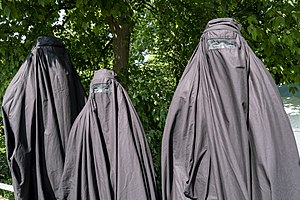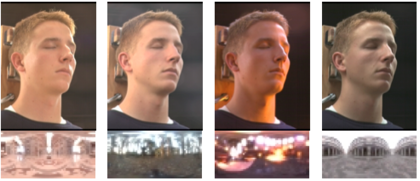Glossary: Difference between revisions
Juho Kunsola (talk | contribs) (→Digital look-alike: + Saying "digital look-alike of X" would imply possession, but "digital look-alike made of X" is more suited, unless the target really is in possession of it.) |
Juho Kunsola (talk | contribs) m (Text replacement - "Adequate Porn Watcher AI" to "Adequate Porn Watcher AI (concept)") Tags: Mobile edit Mobile web edit |
||
| Line 7: | Line 7: | ||
= Adequate Porn Watcher AI = | = Adequate Porn Watcher AI = | ||
See [[Adequate Porn Watcher AI]] | See [[Adequate Porn Watcher AI (concept)]] | ||
---- | ---- | ||
= Appearance and voice theft = | = Appearance and voice theft = | ||
Appearance is thieved with [[digital look-alikes]] and voice is thieved with [[digital sound-alikes]]. These are new and very extreme forms of identity theft. Ban covert modeling and possession and doing anything with a model of a human's voice, but don't ban the [[Adequate Porn Watcher AI]]. | Appearance is thieved with [[digital look-alikes]] and voice is thieved with [[digital sound-alikes]]. These are new and very extreme forms of identity theft. Ban covert modeling and possession and doing anything with a model of a human's voice, but don't ban the [[Adequate Porn Watcher AI (concept)]]. | ||
---- | ---- | ||
Revision as of 18:29, 22 January 2021
This is the SSF! wiki glossary. See resources for examples you will often find linked for your convenience.
ACM
The w:Association for Computing Machinery (ACM) is a US-based international w:learned society for w:computing. It was founded in 1947, and is the world's largest scientific and educational computing society. (Wikipedia)
Adequate Porn Watcher AI
See Adequate Porn Watcher AI (concept)
Appearance and voice theft
Appearance is thieved with digital look-alikes and voice is thieved with digital sound-alikes. These are new and very extreme forms of identity theft. Ban covert modeling and possession and doing anything with a model of a human's voice, but don't ban the Adequate Porn Watcher AI (concept).
Bidirectional reflectance distribution function

“The bidirectional reflectance distribution function (BRDF) is a function of four real variables that defines how light is reflected at an opaque surface. It is employed in the optics of real-world light, in computer graphics algorithms, and in computer vision algorithms.”
A BRDF model is a 7 dimensional model containing geometry, textures and reflectance of the subject.
The seven dimensions of the BRDF model are as follows:
- 3 cartesian X,Y,Z
- 2 for the entry angle
- 2 for the exit angle of the light.
Burqa

“A burqa, also known as chadri or paranja in Central Asia, is an enveloping outer garment worn by women in some Islamic traditions to cover themselves in public, which covers the body and the face.”
Covert modeling
Covert modeling refers to both covertly modeling aspects of a subject i.e. without express consent.
Main known cases are
- Covertly modeling the human appearance into 7-dimensional Bidirectional reflectance distribution function model or other type of model.
- Covertly modeling the human voice
There is work ongoing to model e.g. human's style of writing, but this is probably not as drastic a threat as the covert modeling of appearance and of voice.
Deepfake

Man of Steel produced by DC Entertainment and Legendary Pictures, distributed by Warner Bros. Pictures. Modification done by Reddit user "derpfakes".
This is a sample from a copyrighted video recording. The person who uploaded this work and first used it in an article, and subsequent people who use it in articles, assert that this qualifies as fair use.
“Deepfake (a portmanteau of "deep learning" and "fake") is a technique for human image synthesis based on artificial intelligence. It is used to combine and superimpose existing images and videos onto source images or videos using a machine learning technique called a "generative adversarial network" (GAN).”
DARPA

The Defense Advanced Research Projects Agency (w:DARPA) is an agency of the w:United States Department of Defense responsible for the development of emerging technologies for use by the military. (Wikipedia)
- DARPA program: 'Media Forensics (MediFor)' at darpa.mil since 2016
- DARPA program: 'Semantic Forensics (SemaFor) at darpa.mil since 2019
Digital look-alike
When the camera does not exist, but the subject being imaged with a simulation of a (movie) camera deceives the watcher to believe it is some living or dead person it is a digital look-alike. Alternative term is look-like-anyone-machine.
Saying "digital look-alike of X" would imply possession, but "digital look-alike made of X" is more suited, unless the target really is in possession of it.
Digital sound-alike
When it cannot be determined by human testing, is some synthesized recording a simulation of some person's speech, or is it a recording made of that person's actual real voice, it is a pre-recorded digital sound-alike. Alternative term is sound-like-anyone-machine.
Generative adversial network
“A generative adversarial network (GAN) is a class of g systems. Two neural networks contest with each other in a zero-sum game framework. This technique can generate photographs that look at least superficially authentic to human observers,[1] having many realistic characteristics. It is a form of unsupervised learning]].[2]”
Human image synthesis
“Human image synthesis can be applied to make believable and even photorealistic of human-likenesses, moving or still. This has effectively been the situation since the early 2000s. Many films using computer generated imagery have featured synthetic images of human-like characters digitally composited onto the real or other simulated film material.”
Institute for Creative Technologies
The Institute for Creative Technologies was founded in 1999 in the University of Southern California by the United States Army. It collaborates with the w:United States Army Futures Command, w:United States Army Combat Capabilities Development Command, w:Combat Capabilities Development Command Soldier Center and w:United States Army Research Laboratory.

Light stage

It consists of two rotary axes with height and radius control. Light source and a polarizer were placed on one arm and a camera and the other polarizer on the other arm.
Original image by Debevec et al. – Copyright ACM 2000 – https://dl.acm.org/citation.cfm?doid=311779.344855 – Permission to make digital or hard copies of all or part of this work for personal or classroom use is granted without fee provided that copies are not made or distributed for profit or commercial advantage and that copies bear this notice and the full citation on the first page.

“A light stage or light cage is equipment used for shape, texture, reflectance and motion capture often with structured light and a multi-camera setup.”
MATINE
MATINE (w:fi:MATINE) is the Scientific Advisory Board for Defence of the w:Ministry of Defence of Finland. MATINE is an abbreviation of MAanpuolustuksen TIeteellinen NEuvottelukunta and it arranges an annual public research seminar. In 2019 a research group funded by MATINE presented their work 'Synteettisen median tunnistus' at defmin.fi (Recognizing synthetic media).
Media forensics
Media forensics deal with ascertaining genuinity of media.
“Wikipedia does not have an article on w:Media forensics”
Niqāb

“A niqab or niqāb ("[face] veil"; also called a ruband) is a garment of clothing that covers the face, worn by some muslim women as a part of a particular interpretation of hijab (modest dress).”
No camera
No camera (!) refers to the fact that a simulation of a camera is not a camera. If people realize the differences, and thus the different restrictions by many types of laws e.g. physics, physiology. Analogously see #No microphone, usually seen below this entry.
No microphone
No microphone is needed when using synthetic voices as you just model them, without needing to capture. Analogously see the entry #No camera, usually seen above this entry.
Reflectance capture
Reflectance capture is made by measuring the reflected light for each incoming light direction and every exit direction, often with many different wavelengths. Using polarisers allow to separately capture the specular and the diffuse reflected light. The first known reflectance capture over the human face was made in 1999 by Paul Debevec et al at the w:University of Southern California.
As of 2020-11-19 Wikipedia does not have an article on reflectance capture.
Relighting

Original image Copyright ACM 2000 – http://dl.acm.org/citation.cfm?doid=311779.344855 – Permission to make digital or hard copies of all or part of this work for personal or classroom use is granted without fee provided that copies are not made or distributed for profit or commercial advantage and that copies bear this notice and the full citation on the first page.
Relighting means applying a completely different w:lighting situation to an image or video which has already been imaged. As of 2020-09 the English Wikipedia does not have an article on relighting.
As of 2020-11-19 Wikipedia does not have an article on relighting.
Spectrogram

w:Spectrograms are used extensively in the fields of w:music, w:linguistics, w:sonar, w:radar, w:speech processing, w:seismology, and others. Spectrograms of audio can be used to identify spoken words phonetically, and to analyse the various calls of animals. (Wikipedia)
Speech synthesis
“Speech synthesis is the artificial production of human speech”
Synthetic porn
Synthetic pornography is a strong technological hallucinogen.
Synthetic terror porn
Synthetic terror porn is pornography synthesized with terrorist intent. Synthetic rape porn is probably by far the most prevalent form of this, but it must be noted that synthesizing concentual looking sex scenes can also be terroristic in intent and effect.
Transfer learning
“Transfer learning (TL) is a research problem in machine learning (ML) that focuses on storing knowledge gained while solving one problem and applying it to a different but related problem.”
Voice changer
“The term voice changer (also known as voice enhancer) refers to a device which can change the tone or pitch of or add distortion to the user's voice, or a combination and vary greatly in price and sophistication.”
Please see Resources#List of voice changers for some alternatives.
References
- ↑ Goodfellow, Ian; Pouget-Abadie, Jean; Mirza, Mehdi; Xu, Bing; Warde-Farley, David; Ozair, Sherjil; Courville, Aaron; Bengio, Yoshua (2014). "Generative Adversarial Networks". arXiv:1406.2661 [cs.LG].
- ↑ Salimans, Tim; Goodfellow, Ian; Zaremba, Wojciech; Cheung, Vicki; Radford, Alec; Chen, Xi (2016). "Improved Techniques for Training GANs". arXiv:1606.03498 [cs.LG].